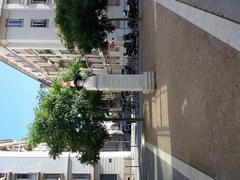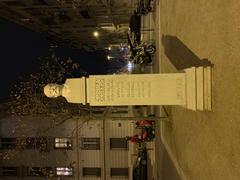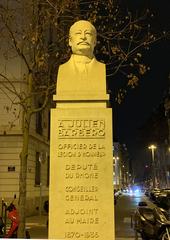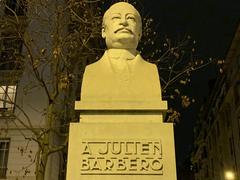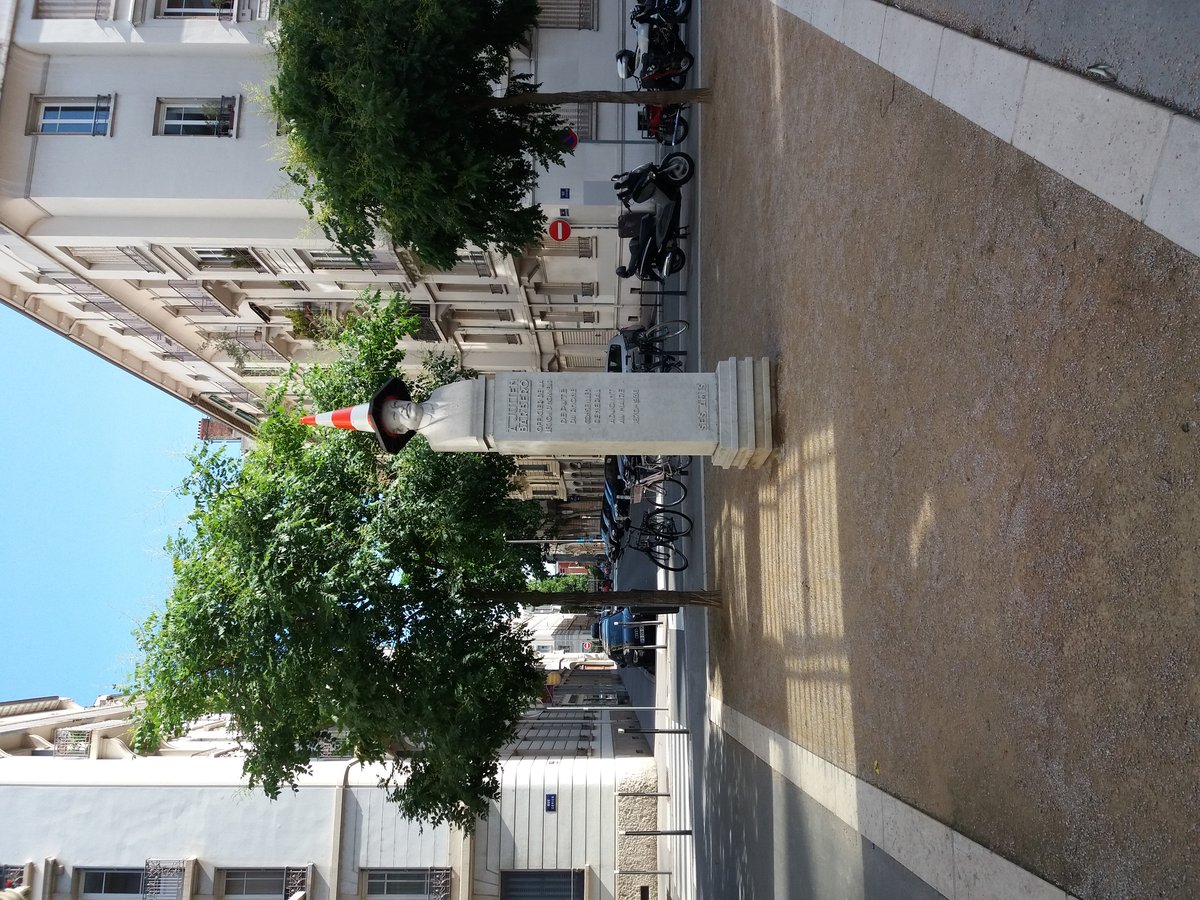
Visiting the Monument À Julien Barbero in Lyon, France: Complete Guide with Tickets, Hours, and Tips
Date: 14/06/2025
Introduction
The Monument À Julien Barbero is a distinctive and meaningful historical landmark in Lyon, France, honoring one of the city’s most dedicated civic leaders. While it may not hold the international acclaim of Lyon’s Basilique Notre-Dame de Fourvière or the city’s ancient Roman ruins, this monument is a vital tribute to the values of social welfare, public service, and community solidarity that define Lyon’s character. This guide provides a comprehensive overview, including the monument’s historical context, artistic features, visiting details, and travel tips to help you make the most of your visit.
Historical and Cultural Significance
The Monument À Julien Barbero is emblematic of Lyon’s tradition of commemorating individuals who have made significant contributions to its civic life. Julien Barbero, born in 1870 in Lagnieu (Ain), was a pharmacist, municipal councillor, deputy mayor, and president of the bureau de bienfaisance for Lyon’s 6th arrondissement. He was a passionate advocate for social justice and public welfare, shaping municipal assistance programs and promoting progressive social policies in the early 20th century (fr.wikipedia.org). Barbero’s work resonated with the values of the Third Republic, a time when France increasingly celebrated civic virtue and local heroes through public monuments (exposition-lyon.com).
The monument was inaugurated in 1938, just two years after Barbero’s death, and was sculpted by Meysson and Alexandre Maspoli. Maspoli was renowned for his postwar memorials and ability to convey both dignity and humanity in his work (en.wikipedia.org). The monument stands as a symbol of Lyon’s appreciation for civic engagement and the enduring influence of local leadership.
Location and Setting
The Monument À Julien Barbero is located on Rue Juliette Récamier in Lyon’s 6th arrondissement, a neighborhood known for its elegant urban planning and proximity to major city attractions like Parc de la Tête d’Or and the Rhône riverbanks. The monument is also referenced in guides covering the Presqu’île and Croix-Rousse districts, reflecting its symbolic presence across several historic neighborhoods (en.visiterlyon.com).
The site is easily accessible via Lyon’s metro, tram, and bus networks, with nearby stops such as Hôtel de Ville–Louis Pradel and Foch. The area is pedestrian-friendly, with paved walkways suitable for all visitors, including those with mobility challenges.
Artistic and Architectural Features
Crafted from durable stone and bronze, the Monument À Julien Barbero features a classical-style bust mounted on a stone pedestal. The sculpture reflects early 20th-century French commemorative art, blending realism and symbolism. Inscriptions detail Barbero’s name, lifespan, and his legacy of public service, inviting passersby to reflect on his contributions. The work of Maspoli and Meysson is evident in the monument’s expressive realism and thoughtful composition, which echo the broader tradition of humanistic public statuary found throughout Lyon (franco.wiki; en.wikipedia.org).
The monument is situated within a landscaped area, often complemented by benches and greenery, creating a contemplative space amid the bustle of the city.
Visiting Hours, Tickets, and Accessibility
- Visiting Hours: The Monument À Julien Barbero is located in a public space and is accessible year-round, 24 hours a day. For safety and optimal viewing, visits during daylight hours are recommended.
- Admission: There is no ticket or admission fee.
- Accessibility: The site is accessible for wheelchair users and those with mobility challenges, thanks to level paving and curb cuts. Public amenities, including restrooms and cafes, are available nearby.
Practical Visitor Tips
- Getting There: Use Lyon’s metro (lines A and C), tram, or bus. Hôtel de Ville–Louis Pradel and Foch stations are within walking distance.
- Best Times to Visit: Early morning and late afternoon offer quieter surroundings and ideal lighting for photography.
- Photography: Visitors are welcome to take photos. Please respect the monument and avoid climbing on the pedestal.
- Safety: The monument is located in a safe, well-lit neighborhood with regular police presence.
- Guided Tours: While there are no tours dedicated solely to the monument, it is often included in walking tours focused on Lyon’s public art and history (en.visiterlyon.com).
Nearby Attractions
The Monument À Julien Barbero is ideally situated near some of Lyon’s key cultural and historical sites:
- Parc de la Tête d’Or: One of Europe’s largest urban parks, perfect for a leisurely stroll.
- Place des Terreaux and the Bartholdi Fountain: Iconic city center with the Musée des Beaux-Arts.
- Grand Hôtel-Dieu: Historic hospital complex turned shopping and dining destination.
- Mur des Canuts: A famous mural celebrating Lyon’s silk workers in the Croix-Rousse district.
- Traboules: Explore Lyon’s unique secret passageways in Vieux Lyon and Croix-Rousse.
- Théâtre des Célestins: Renowned theater just south of Presqu’île.
Commemorative Practices and Public Engagement
The monument is not only a site of remembrance but also an active part of Lyon’s cultural life. It serves as a gathering place for annual commemorations, particularly around Labor Day (May 1st), and is often included in educational programs for local schools. Interpretive signage and heritage trail markers may be present, providing context for visitors.
Sustainability and Responsible Tourism
Lyon encourages eco-friendly travel. The monument is easily accessible by public transportation, bike (using Lyon’s Vélo’v system), or on foot. Please be respectful of the site and its surroundings to help preserve this important cultural landmark for future generations (en.visiterlyon.com).
Frequently Asked Questions (FAQ)
Q: Is there an entrance fee to visit the Monument À Julien Barbero?
A: No, the monument is free to visit at all times.
Q: What are the opening hours?
A: The monument is outdoors and accessible 24/7; visits during daylight are recommended.
Q: Is the site wheelchair accessible?
A: Yes, the area is suitable for visitors with mobility challenges.
Q: Are guided tours available?
A: The monument is included in many walking tours focused on Lyon’s history and public art (en.visiterlyon.com).
Q: What other sites should I visit nearby?
A: Parc de la Tête d’Or, Place des Terreaux, the Mur des Canuts, and the traboules.
Visuals

Image: The Monument À Julien Barbero, featuring its bronze bust and stone pedestal in a landscaped square in Lyon.
For more images and details, visit the Wikimedia Commons gallery.
Summary and Recommendations
The Monument À Julien Barbero is a testament to Lyon’s values of social progress, civic engagement, and respect for those who have advanced the city’s welfare. Its accessible location, free admission, and integration into the city’s vibrant neighborhoods make it a rewarding stop for visitors interested in Lyon’s layered history. Enhance your visit by exploring nearby attractions, joining a guided tour, or downloading interactive maps and virtual tours through platforms like the Audiala app and the ONLYLYON Tourist Office.
Additional Resources and Official Links
- Les monuments emblématiques de Lyon : un guide, 2025, Exposition Lyon
- Julien Barbero (Wikipedia)
- Alexandre Maspoli (Wikipedia)
- Remarkable sites and monuments, Lyon UNESCO Heritage, En.visiterlyon
- Monument à Julien Barbero: Visiting Hours, Tickets, and Historical Significance, Franco Wiki
- Visiting the Monument À Julien Barbero in Lyon: Presqu’île District, Visiter Lyon
- Monument À Julien Barbero in Lyon, Wikimedia Commons
- Monument À Julien Barbero: Guide to Lyon Historical Sites, Vanupied, The Crazy Tourist, Lyon Secret, The Crazy Tourist, Lyon Secret
Enjoyed this guide?
Download the Audiala app for more Lyon travel tips, follow us on social media for updates on Lyon’s historical sites, and explore our related posts about Lyon’s rich heritage.
